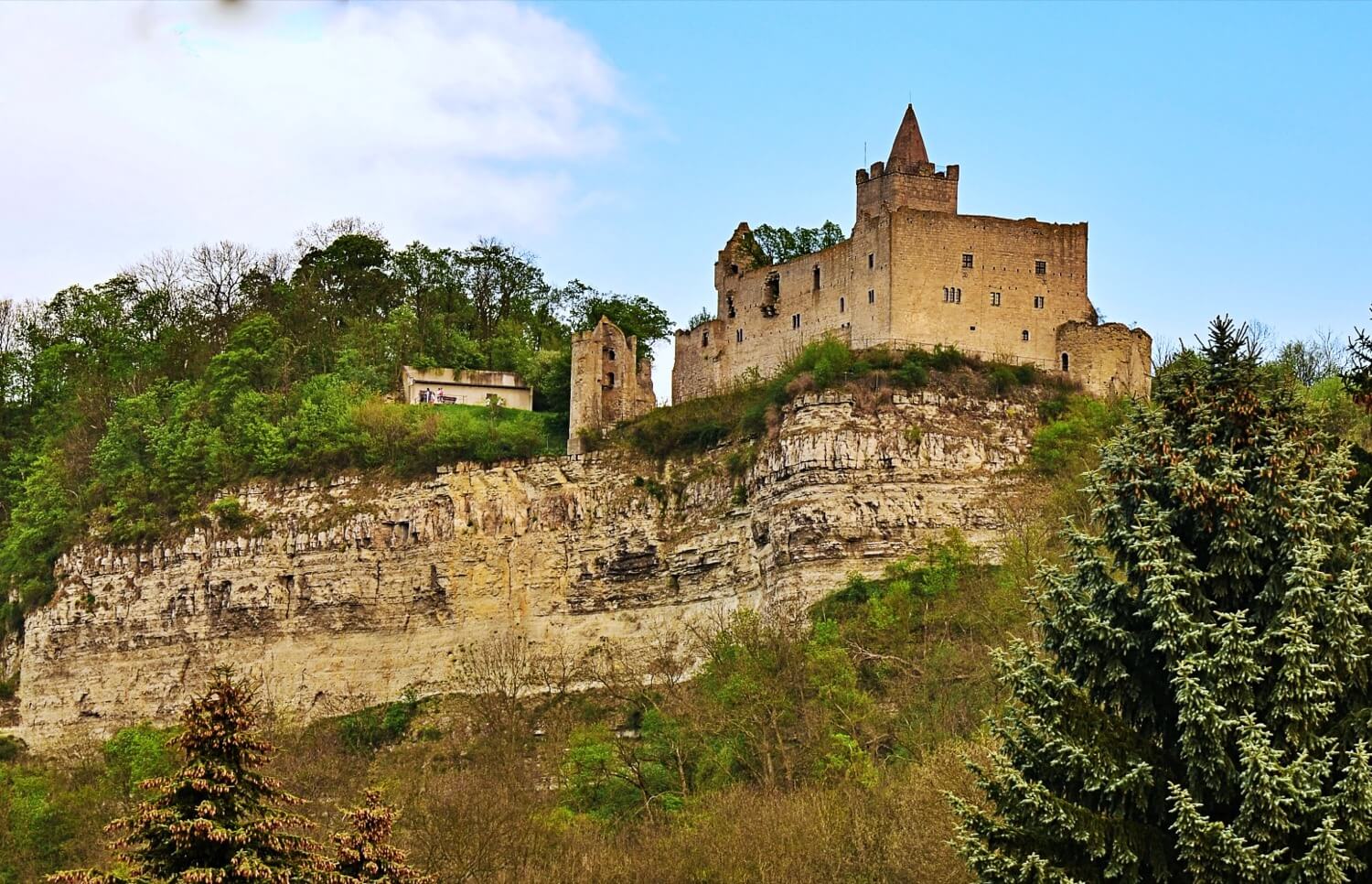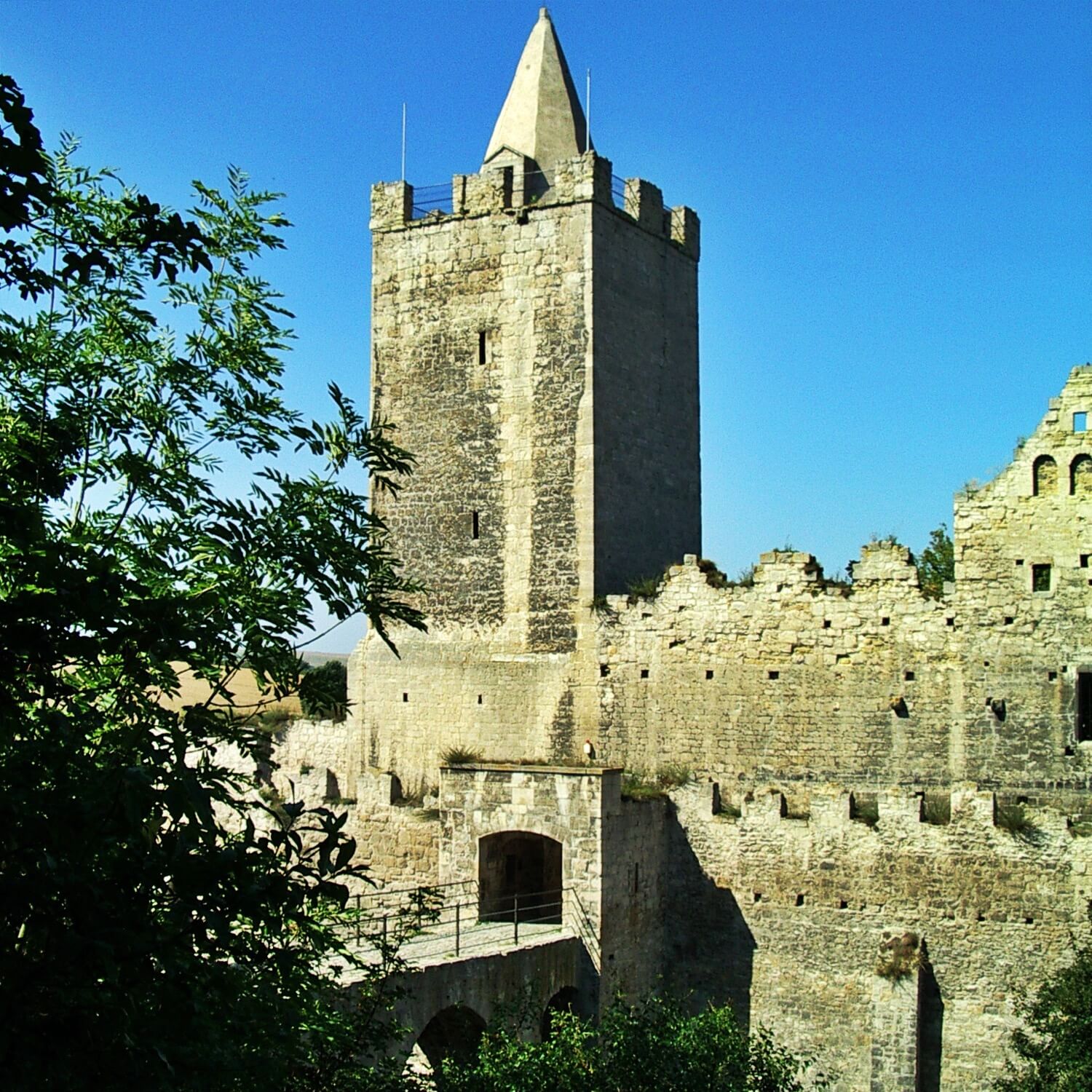Rudelsburg
Burgenlandkreis Sachsen-Anhalt Germany
castle, chateau
Rudelsburg
Burgenlandkreis Sachsen-Anhalt Germany
castle, chateau
The Rudelsburg is a ruined hill castle located on the east bank of the river Saale above Saaleck, a village in the borough of Naumburg in the county of Burgenlandkreis in Saxony-Anhalt, Germany
Die Rudelsburg ist eine Höhenburg oberhalb Saaleck im Burgenlandkreis in Sachsen-Anhalt
Previous names
Rudelsburg, Rudelsburg
Description
The Rudelsburg is a ruined hill castle located on the east bank of the river Saale above Saaleck, a village in the borough of Naumburg in the county of Burgenlandkreis in Saxony-Anhalt, Germany. The Rudelsburg was built in the Middle Ages by the Bishop of Naumburg and served to secure trade routes such as the Via Regia through the Saale Valley.
The Rudelsburg was a point of conflict between the bishops of Naumburg and the Margraves of Meissen belonging to the House of Wettin. The castle occasionally served various noble families as a residence, until it was destroyed in the Thirty Years' War and thereafter fell into disrepair. In the early 19th century the Rudelsburg became a popular tourist destination thanks to the romanticisation of mountains and the rise of hiking as a pastime. From 1855 onwards it achieved national renown as the annual meeting place of the Kösener Senioren-Convents-Verband, the oldest union of student fraternities with delegates from all German-speaking countries. The Rudelsburg still maintains a particular attraction for visitors and lies on the Romanesque Road (Ger:Straße der Romanik), a tourist route.
History
Archaeological finds seem to indicate that an early Bronze Age settlement existed on the site of the Rudelsburg, which has been attributed to the Unetice culture. The discovery of the Nebra sky disk attracted public attention to this prehistoric civilisation and its elevated culture and provoked interest in the settlements in the region of Saxony-Anhalt and Thuringia. The political, religious and economic importance of such settlements has not yet been established, but is the focus of intense research.
Military fortification and seat of nobility
The Rudelsburg castle was established in 1050 as a border fortification and was extended around 1150, with the addition of the central and outer keeps. Not far away on the western knoll is the ruin of Saaleck Castle. Rudelsburg was officially mentioned for the first time in 1171 under the name Rutheleibisberg.
Heinrich III, Margrave of Meissen, received the castle from the Bishop from Naumburg in 1238 as recompense for services to the church and installed there a number of families belonging to the nobility of service (retainers to a lord whose status was far above that of the peasantry but who nonetheless did not belong to the ranks of the high nobility). A source from 1271 names 12 different castellans. A priest is mentioned for the first time in 1293.
During a dispute with the noble Curtefrund, the citizens of Naumburg led by their captain Johann von Trautzschen laid siege to the Rudelsburg from 22 April to 30 July 1348. The sources relate that an “instrumentum” was brought to bear during the siege that could shoot Greek fire.[1] This must have been some early form of gunpowder and is thought to be one of the first records of the use of firearms in a siege in Germany. The only earlier recorded use of ordnance dates back to the siege of the town of Meersburg on Lake Constance by Ludwig von Bayern in 1334. The oldest reports in all of Europe are from Italy (Florence 1326, Cividale 1331) and from the French fleet (1338-1346).
The citizens of Naumburg burnt down the Rudelsburg during their siege, and there were deaths and injuries on both sides. It seems that the castle was not rebuilt, as it is not mentioned in any official document for several decades after this event.
The next mention of the castle dates to 1383, when the Schenk family from Saaleck belonging to the House of Vargula are named as masters of the citadel, seated in Rottelsburg.
A loan certificate of the Dukes of Saxony, who belonged to the House of Wettin, dated 2 April 1441 names the brothers Rudolf, Günther and Heinrich von Bünau as the owners of the Rudelsburg. Apparently they owned no land other than that on which the castle stood.
During the fratricidal war between Friedrich and Wilhelm of Saxony, the Rudelsburg was besieged and destroyed for a second time in 1450. The inner keep was burnt to the ground during this incident.
At the division of the lands of the House of Wettin in 1485, the Rudelsburg was attributed to the Albertine line.
Rudolph von Bünau auf Teuchern and Günther von Bünau auf Gröbitz sold the Rudelsburg and the surrounding outworks to Hans Georg von Osterhausen in 1581 to cover their debts. The castle, which had been barely maintained until then, began to fall into decay during this period.
Although Groitzsch still describes the Rudelsburg as arx pulcherrima ("most beautiful castle") in his 1585 work Descriptio Salae fluvii eidemque adjacentium urbium, arcium etc. (Description of the river Saale and the surrounding towns, castles, etc.), a record from 1612 indicates that the lord marshal of Osterhausen employed a stonemason and a carpenter to provide "necessary support of the sagging beams, girders and rafters".
According to Osterhausen court records, a process was held at the Rudelsburg on 4 June 1616. At the time, a caretaker still lived in the castle, which was accessible via a narrow road. The courtyard was covered in grass. Besides a small room with a wooden pulpit, the usable remains of the castle included the dungeons with their very strong doors.
Towards the end of the Thirty Years' War in 1640, Swedish troops set fire to the Rudelsburg. Following this third destruction, the Rudelsburg was abandoned on 14 April 1641 and the inhabitants moved to the nearby Kreipitzsch property.
The nobles from Creutz(en) are believed to have been the owners of the Rudelsburg from 1671 to 1771. In 1690, they tried to establish the status of the (uninhabited) castle as a possession owing direct allegiance only to the emperor (Reichsunmittelbarkeit) in a court process in the imperial court in Wetzlar.
In 1770, the owner of the Rudelsburg ordered that the walls of the outer keep be torn down in order to reuse the stones for construction on the property, but a worker was permanently injured in an accident, and this was interpreted as a bad omen. The work was stopped. The outer keep was almost completely destroyed at this point in time, and it is probably only as a result of this accident that the ruined inner keep was preserved.
With the death of Friedrich Adolph von Creutz in 1774, the male line of the family was extinguished. This thwarted the plans to establish the Reichsunmittelbarkeit of the Rudelsburg.
In the following years, the counts from Zech and the counts from Brühl are named briefly as the owners of the Rudelsburg. The family von Schönberg bought the castle in 1797 and established an entailment, i.e. an indivisible trust that was designed to keep together the inheritance of the family.
The Rudelsburg as a destination for hikers and a tourist attraction
In the 19th century, the Rudelburg became a meeting point for romantically-minded hikers, especially for students from Jena, Leipzig and Halle.
By this time, the castle was desolate, and devoid of all infrastructure. There was no entrance into the courtyard of the central keep and there were no sealed rooms, just rubble and debris. In 1818, the cantor emeritus, Johann Friedrich Förtsch, described the Rudelsburg as follows:
“The inner courtyard is covered in the rubble of the various ceremonial halls, chambers, weapon and storage rooms, kitchens, underground vaults, cellars and corridors, which have collapsed. It is thus impossible to say how everything used to be arranged.”
Nonetheless, ever more visitors came to the Rudelsburg. During the same period, the masters of the castle belonging to the family of the barons von Schönberg planted grapevines on the southern slope of the hill. One of the former vineyard workers, Gottlieb Wagner, known as “Samiel”, began to look after the ruins. From 1824 onwards, he offered food and drink from the Kreipitzsch property to visitors.
In this song, the castles on the Saale are decaying ruins that serve only to inspire the imagination. There is as yet no mention of drinking and celebrations or of the Rudelsburg as a venue for events.
The attractiveness of the castle rose however with the services offered by Wagner, so much so that the head of the district authorities in Naumburg asked Friedrich von Schönberg, the owner of the property, if it would be possible to open it officially for visitors. Consequently, a road was even built up to the castle.
Gottlieb Wagner opened the first tavern in the castle in time for Easter 1827, although it was only open on Sundays at first. When word got around about this development amongst the students in Jena, they marched on the Rudelsburg and, cheering loudly, occupied it for three days. The owner of the castle was honoured with a torchlight procession.
The completion of the Thuringian Railway in 1849, which improved the access to the Rudelsburg, coupled with the gastronomic offerings, further increased the attractiveness of the castle and brought in visitors from further abroad, including for example students from Leipzig and Halle an der Saale.
During a large-scale Prussian military exercise in the area in 1853, the provincial classes invited King Frederick William IV to breakfast at the castle. The drinking hall in the inner courtyard, which was built in the same year, is probably a product of this visit. The hall took the form of a roofed seating area that was open to the courtyard and replaced the old straw roof that had been held up by simple tree trunks.
Die Rudelsburg ist eine Höhenburg oberhalb Saaleck im Burgenlandkreis in Sachsen-Anhalt. Sie liegt etwa 85 Meter über dem Südufer der Saale auf einem felsigen Bergrücken aus Muschelkalk. Die Burg wurde wohl von den Bischöfen von Naumburg im Hochmittelalter zur Sicherung der Handelswege wie der Via Regia mit der Saalebrücke in Bad Kösen angelegt. Bei der ersten Erwähnung 1171 war sie im Besitz von Naumburger Ministerialen. 1238 wurde sie an die Markgrafen von Meißen verlehnt und als Befestigungsbau urkundlich genehmigt. Die Burg befand sich im Spannungsfeld der Interessen der Naumburger Bischöfe und der Markgrafen von Meißen aus dem Hause Wettin. 1348 erfolgte die Zerstörung und Schleifung der Vorburg durch die Stadt Naumburg.
Zeitweise diente die Burg verschiedenen Adelsfamilien als Wohnsitz, bis sie im Dreißigjährigen Krieg zerstört wurde und daraufhin verfiel. Als „schönste aller Saaleburgen“ wurde die Ruine der Rudelsburg schon früh im 19. Jahrhundert im Zuge der Burgenromantik und des Wandertourismus als Ausflugsziel entdeckt. Als alljährlicher Treffpunkt der Kösener Corpsstudenten erreichte die Rudelsburg ab 1855 überregionale Bekanntheit. Bis heute stellt sie ein beliebtes Ausflugsziel dar. Sie liegt auf der Südroute der Straße der Romanik.
Geschichte
Adelssitz im Mittelalter und in der frühen Neuzeit
Erst im Frühmittelalter wurde der Bergrücken erneut genutzt, wie einige Funde von in slawischer Herstellungstradition stehender Keramik der Leipziger Gruppe zeigen. Umfang, Intensität und Zeitdauer der Besiedlung, die nur allgemein in das 10. und 11. Jahrhundert zu setzen ist, kann jedoch nicht bestimmt werden. Die Rudelsburg dürfte jedoch zu den zahlreichen Burgwällen im Gebiet von Saale und Elbe gehört haben wie etwa dem einige Kilometer saaleaufwärts gelegenen Johannisberg bei Jena-Lobeda oder der Alte Gleisberg bei Bürgel. Für die von der heimatkundlichen Forschung am Ende des 19. Jahrhunderts aufgestellte und bis heute häufig fortgeschriebene Behauptung, die Rudelsburg sei im oder um das Jahr 1030 bzw. 1050 als Grenzbefestigung errichtet worden, gibt es dagegen keinerlei historischen Beleg.
In der Mitte des 12. Jahrhunderts ließen die Bischöfe von Naumburg auf dem westlichen Ende des Bergrückens eine Burg errichten und mit Ministerialen besetzen. Im Jahr 1171 wurde erstmals ein Hugo de Ruthelebesburch urkundlich genannt, der dem Geschlecht der Herren von Schönburg entstammt. Mit dem Ausbau der Burg in ihrer heutigen Gestalt ist etwa zu dieser Zeit begonnen worden. Bereits am Ende des 12. Jahrhunderts war sie in ihren wesentlichen Teilen fertiggestellt. 1238 belehnte der Naumburger Bischof den Markgrafen von Meißen Heinrich den Erlauchten mit oppidum et castrum Ruthleibesberch, der die Herrschaftsausübung vor Ort weiterhin in die Hände von Ministerialen legte.
In einer 1271 ausgestellten Urkunde werden zwölf castellani in Ruthleibisberch, d. h. Burgmannen, namentlich genannt. Im Jahre 1293 wurde erstmals ein Priester auf der Burg erwähnt. Östlich der Burg (castrum) bestand demnach spätestens zu dieser Zeit eine stadtähnliche Siedlung (oppidum). Das ausgedehnte Areal der Vorburg war im Westen, Süden und Osten mit Ringmauer, Graben und Wall befestigt und besaß zwei Tore zur Burg hin und am gegenüberliegenden Ende. Hier hatten vermutlich die Burg- und Dienstmannen ihren Sitz. Bei den archäologischen Ausgrabungen wurden mehrere Reste von Gebäuden aus Stein und Fachwerk angetroffen, die sich bis dicht an die Ringmauer heranzogen.
Zwischen dem 22. April und dem 30. Juli 1348 belagerten die Naumburger Bürger unter ihrem Capitaneus Johann von Trautzschen auf Beschluss des Stadtrates im Rahmen einer Fehde mit dem Edlen Curtefrund die Rudelsburg. Die Quellen sprechen davon, dass bei der Belagerung ein instrumentum zum Einsatz gekommen sein soll. Dabei bleibt offen, ob es sich um eine Steinschleuder, eine sogenannte Blide, handelte, oder, wie bisweilen angenommen, um eine der ersten Feuerwaffen. Dabei soll die Rudelsburg erstürmt und zerstört worden sein, wobei es auf beiden Seiten Tote und Verletzte gab. Mindestens einer der Kastellane geriet dabei auch in Gefangenschaft. Wesentlich stärker als die Kernburg war offenbar die Vorburg betroffen, die von der Stadt vermutlich als wirtschaftliche Konkurrenz angesehen und ausgeschaltet worden war. Ein bei den jüngsten archäologischen Ausgrabungen untersuchter Steinkeller war vollständig mit Brandschutt verfüllt, in dem zahlreiche Bruchstücke von Tafelgeschirr, Spielzeug und Metallobjekten lagen.
1383 wurde die Familie der Schenken von Saaleck aus dem Haus der Schenken von Vargula als „Herren von der Veste, gesessen zu Rottelsburg“ genannt. Eine Lehnsurkunde der Herzöge von Sachsen aus dem Haus Wettin vom 2. April 1441 weist die Brüder Rudolf, Günther und Heinrich von Bünau als Inhaber der Burg aus. Noch um 1510 hatten sie kein Land außerhalb des Burggeländes.[6] Im Sächsischen Bruderkrieg zwischen Friedrich und Wilhelm von Sachsen wurde die zum Anteil Wilhelms III. gehörige Rudelsburg 1450 erneut belagert und ein zweites Mal zerstört. Die innere Burg wurde dabei eingeäschert. Bei der Teilung der wettinischen Lande im Jahr 1485 wurde die Rudelsburg als Besitzung der Herren von Bünau der albertinischen Linie des Hauses zugeschlagen. Im Jahre 1538 belieh der Naumburger Bischof Philipp die Herren von Bünau und Ritter der Rudelsburg mit den ihnen angefallenen stiftischen Lehen, u. a. dem Vorwerk Kreipitzsch und neun Hufen im Amt Camburg.
Rudolph von Bünau auf Teuchern und Günther von Bünau auf Gröbitz verkauften 1581 die Rudelsburg mit den dazugehörigen Vorwerken Kreipitzsch und Krölp oder Krulpe, sowie den Ort Naumburg wegen Schulden an den Amtsschösser zu Eckartsberga, Hans George von Osterhausen. In dieser Zeit begann der nur notdürftig verzögerte Verfall der Burg. Im 1584 gedruckten Buch Libellus Continens Salae Flvvii descriptionem, eidemqve adiacentium Oppidorvm, Arcivm, Coenobiorvm Et Episcopalivm sedium, situs, fundationes & antiquitates von Gregor Groitzsch wird die Rudelsburg noch als arx pulcherrima, als „schönste Burg“, bezeichnet. Die Rudelsburg und der Ort Lengefeld gehörten seit Mitte des 16. Jahrhunderts als Exklave zum kursächsischen Amt Eckartsberga. Der zur Rudelsburg gehörige Gutsbezirk Kreipitzsch unterstand jedoch als Lehen des Hochstifts Naumburg-Zeitz dem 1544 gebildeten Amts Naumburg, welches ab 1564 unter kursächsischer Hoheit stand.
Ein Protokoll aus dem Jahre 1612 bezeugt, dass der Herr Marschall von Osterhausen zu Dresden einen Ziegeldecker und einen Zimmermann zur „nottdürftigen Unterstüttzung der eingesunkenen Träger, Balken, Stühle und Sparren“ auf der Burg anheuerte. Nach den Angaben in Gerichtsbüchern der Familie von Osterhausen wurde am 4. Juni 1616 auf der Burg ein Gerichtstag gehalten. Zu der Zeit wohnte nur noch ein Hausmann auf der Burg, zu der ein enger Fahrweg führte. Der Hof war grasbewachsen. Außer einer Stube mit einem hölzernen Predigtstuhl gab es noch tiefe Gefängnisse mit sehr starken Türen. 1640 wurde die Rudelsburg gegen Ende des Dreißigjährigen Krieges von den Schweden niedergebrannt. Nach dieser dritten Zerstörung wurde die Rudelsburg am 14. April 1641 von den Bewohnern verlassen. Die Besitzer zogen auf das Gut Kreipitzsch um.
Von 1671 bis 1774 gelten die Edlen von Creutz(en) als Besitzer der Burg. In einem Prozess vor dem Reichskammergericht in Wetzlar versuchten sie im Jahre 1690, die Reichsunmittelbarkeit der unbewohnten Burg durchzusetzen. Die zu ihr gehörigen Orte Kreipitzsch, Freiroda und Lengefeld galten jedoch als eigenständige Lehen, die unter der Herrschaft des Kurfürstentums Sachsen standen oder ebenfalls reichsfrei waren. Im Jahre 1770 ließ der Besitzer die Mauern der Vorburg abreißen, um Steine für den Bau des Gutes zu gewinnen. Durch einen Arbeitsunfall wurde ein Arbeiter schwer verletzt und trug eine dauerhafte Behinderung davon. Das wurde als böses Omen gewertet, und die Arbeiten wurden eingestellt. Die Vorburg war zu dem Zeitpunkt aber bereits fast vollständig vernichtet. Vermutlich nur durch diesen Unfall blieb die Ruine der Kernburg erhalten. Mit dem Tode des hessischen Hauptmanns Friedrich Adolph von Creutz im Jahre 1774 erlosch die Linie Frohburg, Ast Rudelsburg der Familie im Mannesstamm.
In den folgenden Jahren wurden die Grafen von Zech und die Grafen von Brühl als kurzzeitige Besitzer der Rudelsburg mit Lengefeld genannt. Die Familie von Schönberg kaufte die Burg 1797 und errichtete ein Fideikommiss, eine unveräußerliche Adelsstiftung, die das Erbe der Familie zusammenhalten sollte.
Wanderziel und Touristenattraktion
Im 19. Jahrhundert wandelte sich die Rudelsburg zum Treffpunkt romantisch gesinnter Wanderer, besonders der Studenten aus Jena, Leipzig und Halle.
Der Zustand des Gebäudes war desolat, Infrastruktur nicht vorhanden. Es gab keine Zufahrt, und im Innenhof der Kernburg gab es keine geschlossenen Räumlichkeiten, sondern nur Schutt und Trümmer. Im Jahre 1818 beschrieb der emeritierte Kantor Johann Friedrich Förtsch die Rudelsburg:
Der innere Hof der Burg ist mit dem Schutt von zusammengestürzten Prunkzimmern, Sälen, Waffen- und Vorrathskammern, Küchen, unterirdischen Gewölben, Kellern und Gängen angefüllt. Daher kann man auch jetzt nicht genau beurteilen, wie Alles angelegt gewesen.
Trotzdem kamen immer mehr Besucher. Die Burgherren aus der Familie der Freiherren von Schönberg bauten damals am Südhang der Burg Wein an (siehe dazu: Weinanbaugebiet Saale-Unstrut-Region). Einer ihrer ehemaligen Weinbergarbeiter, Gottlieb Wagner, genannt „Samiel“, kümmerte sich als Burgwart zuerst um das verfallene Gemäuer und begann im Jahre 1824, die Besucher vom Gut Kreipitzsch aus zu bewirten.
In diesem Lied sind die Saaleburgen verfallene Ruinen, die nur Phantasien von alten Zeiten wecken. Von Trinken und Feiern und von der Rudelsburg als Veranstaltungsort ist noch nicht die Rede. Wahrscheinlich stammt die Gedenktafel von Oskar Mothes, dem Erbauer der Gefallenensäule, 1872.
Die Attraktivität der Burg wurde aber durch die Bewirtung derart gesteigert, dass im Jahre 1827 der Landrat des Stadtkreises Naumburg beim Gutsbesitzer Friedrich von Schönberg anfragen ließ, ob es nicht möglich sei, die Burg offiziell für Besucher zu öffnen. In Folge wurde sogar wieder ein Fahrweg auf die Burg gebaut.
Ostern 1827 richtete Gottlieb Wagner die erste Schänke auf der Burg ein, die jedoch anfänglich nur sonntags geöffnet war. Als sich diese Neuerung bei den Studenten herumgesprochen hatte, zogen sie von Jena heran und besetzten mit lautem Jubel drei Tage lang die Burg. Dem Burgbesitzer wurde aus Dankbarkeit ein Fackelzug dargebracht.
Die verbesserte Infrastruktur, auch durch die bis 1849 fertiggestellte Thüringer Bahn, und das gastronomische Angebot erhöhte die Attraktivität der Burg weiterhin und lockte auch Besucher aus größerer Entfernung an, so zum Beispiel die Studenten aus Leipzig und Halle an der Saale.
Als im Jahre 1853 ein größeres preußisches Militärmanöver in der Gegend abgehalten wurde, luden die sächsischen Provinzialstände König Friedrich Wilhelm IV. zu einem Frühstück auf die Burg ein. Vermutlich aus diesem Anlass entstand in dem Jahr die Trinkhalle im Innenhof, die aus einer überdachten Sitzfläche bestand, die zum Burghof hin offen war. Diese Halle löste das alte Strohdach ab, das von einfachen Baumstämmen gestützt wurde.
Im Jahre 1863 schuf Hermann Allmers aus Rechtenfleth bei Bremen (kein Student, aber in studentischer Gesellschaft im Saaletal unterwegs) das Studentenlied „Dort Saaleck, hier die Rudelsburg“, in dessen Text schon das neue Leben in den Mauern anklingt. Eine Bronzetafel von 2005, gestiftet vom Corps Teutonia Marburg, erinnert daran.
Im Juni 1848 trafen sich 500 Corpsstudenten auf der Rudelsburg, um die Gründung eines Dachverbandes in die Wege zu leiten; umgesetzt wurde der Beschluss einen Monat später in der Universität Jena. Seit 1849 tagt dieser älteste Dachverband deutscher Studentenverbindungen in Kösen und heißt seither Kösener Senioren-Convents-Verband (KSCV). Die Rudelsburg ist seine Mitte und wird für Arbeitssitzungen und Festveranstaltungen genutzt.
Useful information
Gratis
Gratis
Burgturm: 1.00 EUR
- Schöne Aussicht
- Informationstafeln
- Ruinen der Burg
- Für Rollstühle nicht zugänglich
- Teilweise als Restaurant genutzt
-
External links
Nearby castles
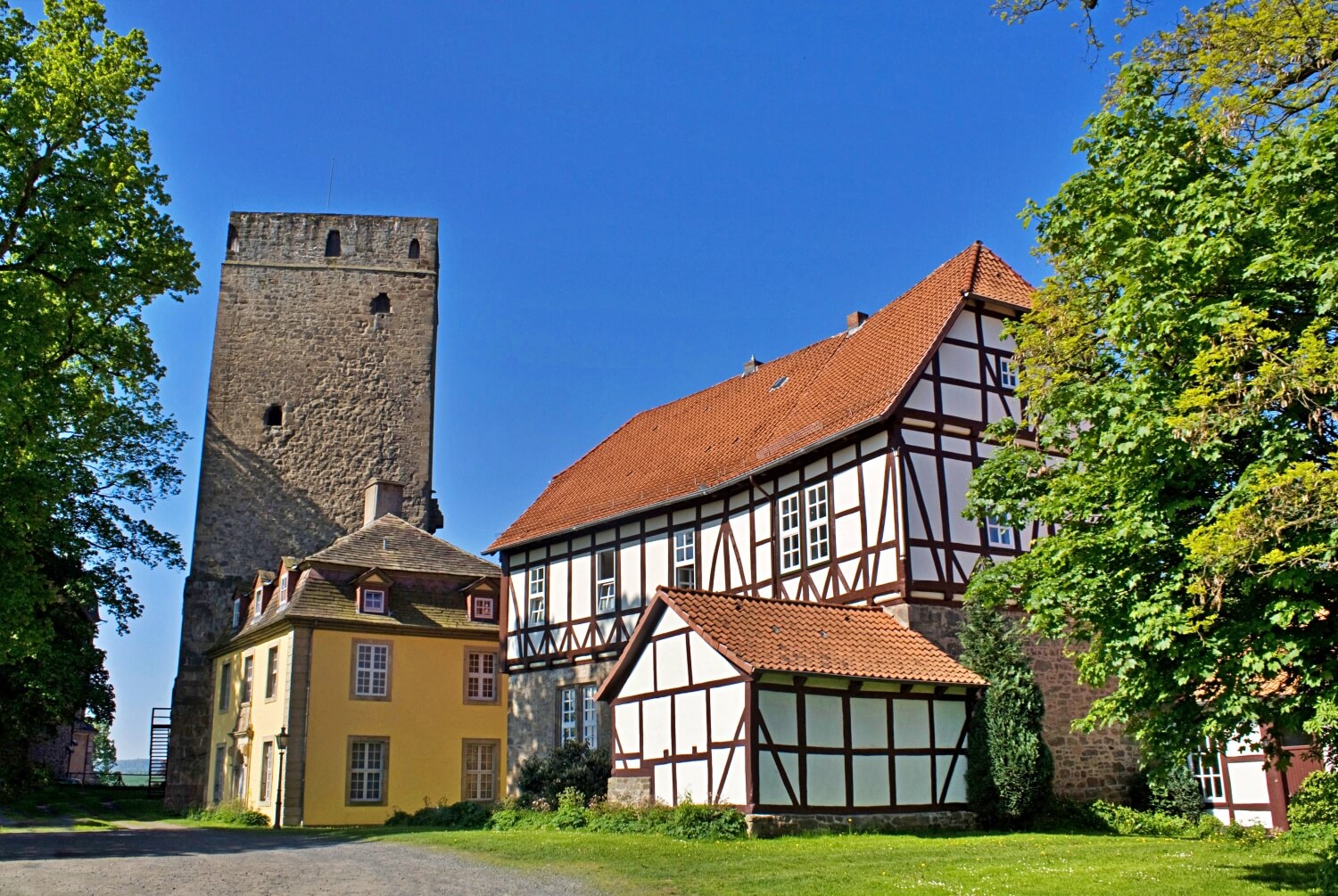
Burg Saaleck
Burgenlandkreis
0.4km
castle, chateau
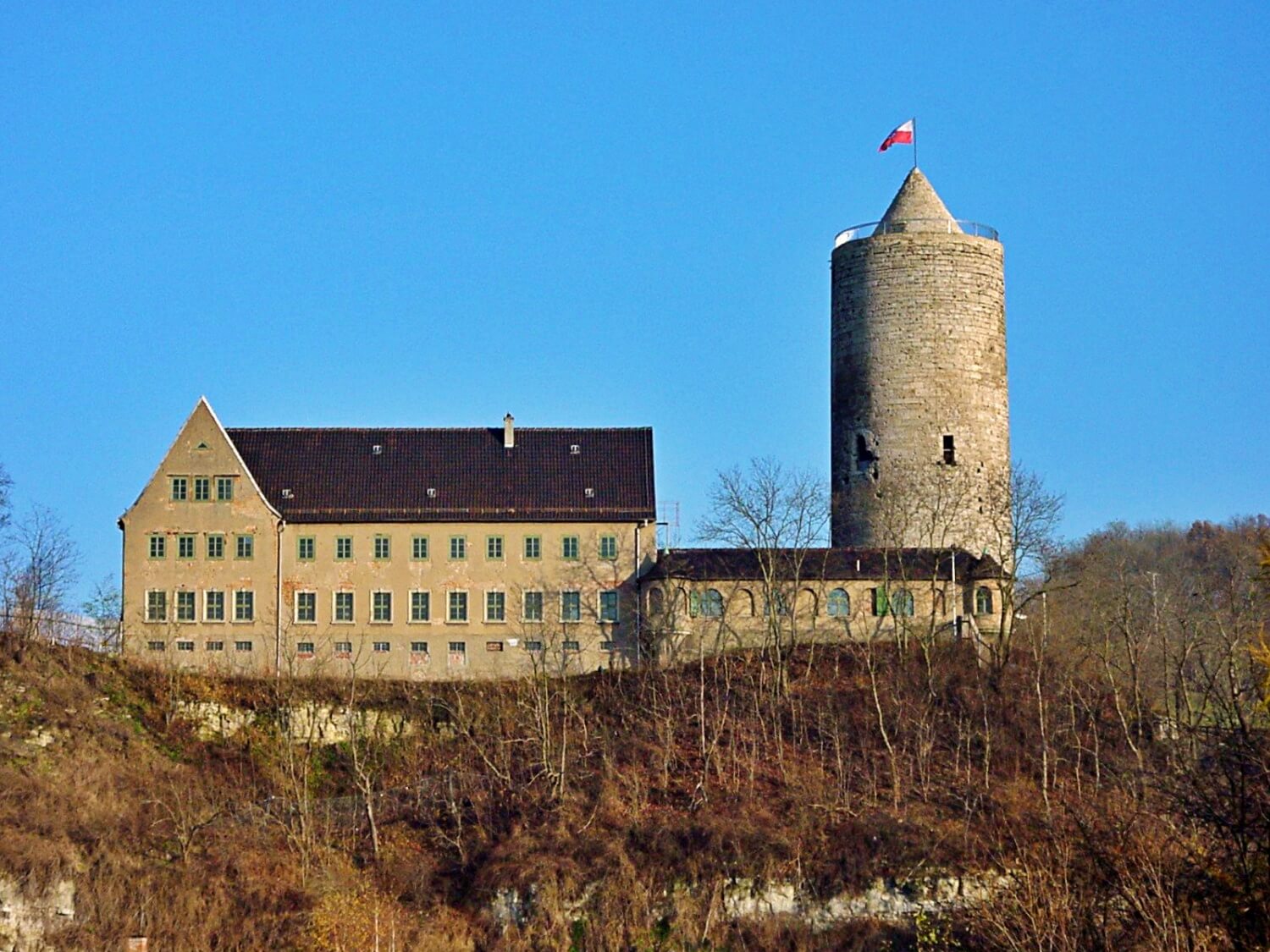
Burg Camburg
Saale-Holzland-Kreis
6.3km
castle, chateau
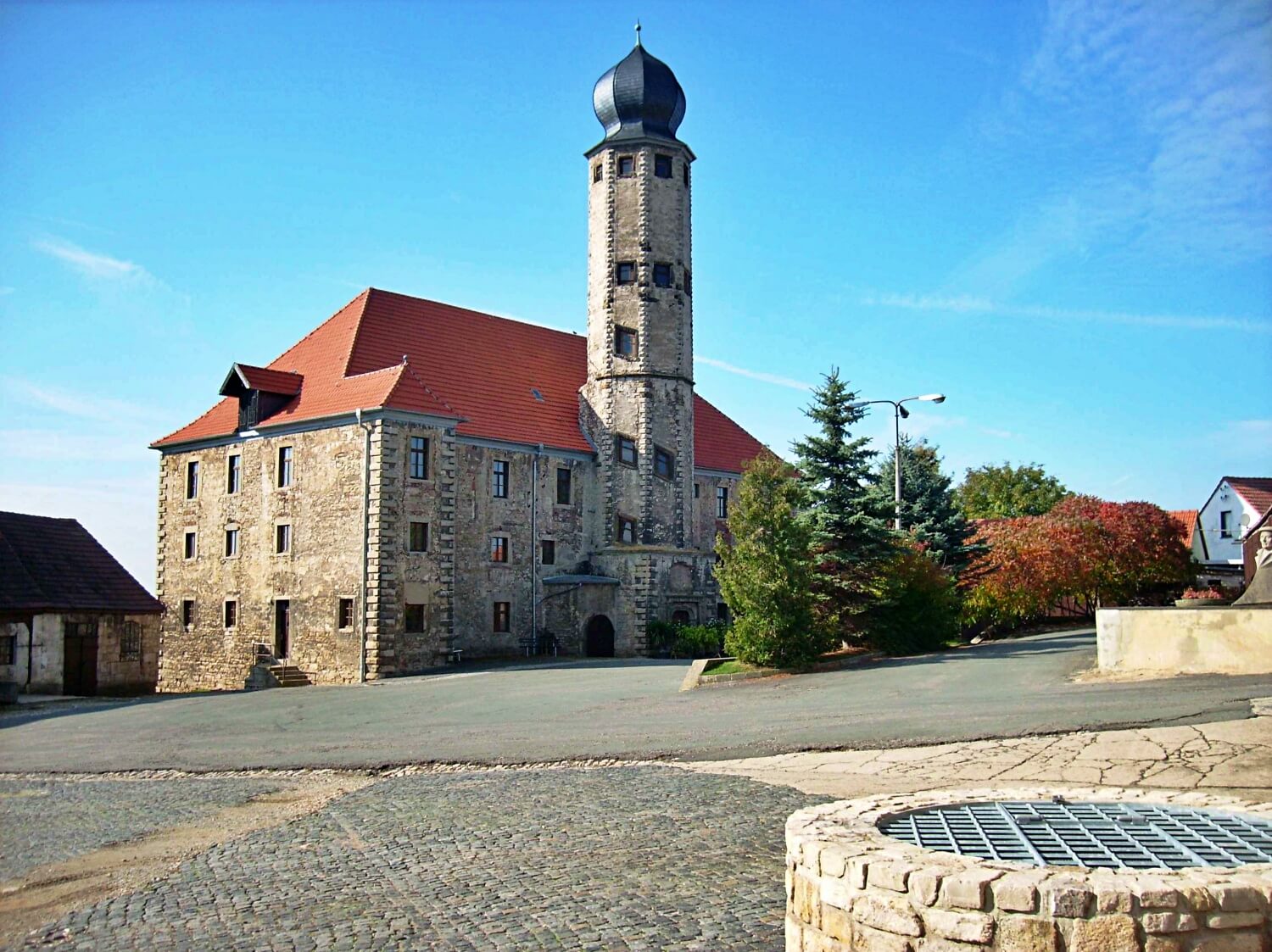
Schloss Frauenpriessnitz
Saale-Holzland-Kreis
10.5km
castle, chateau
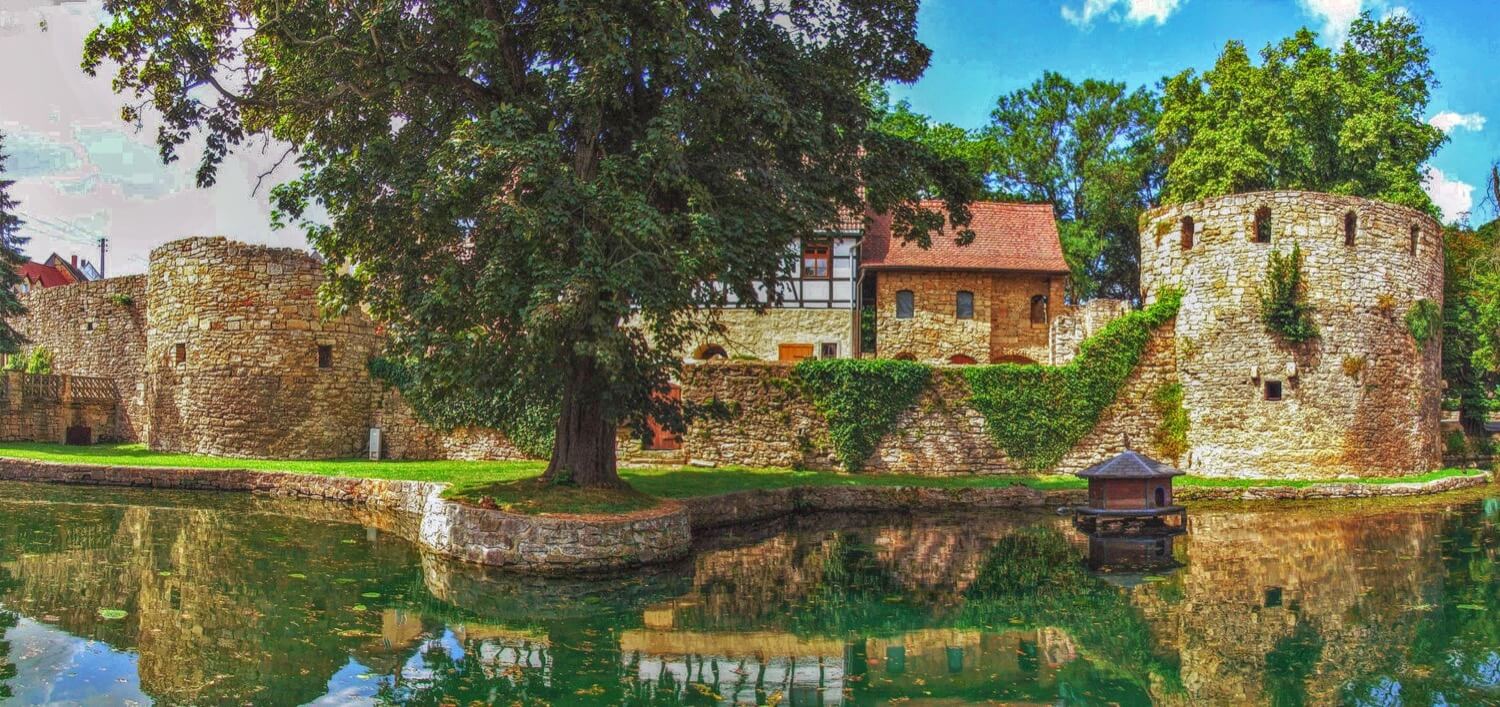
Schkölen Castle
Saale-Holzland-Kreis
10.8km
castle, chateau
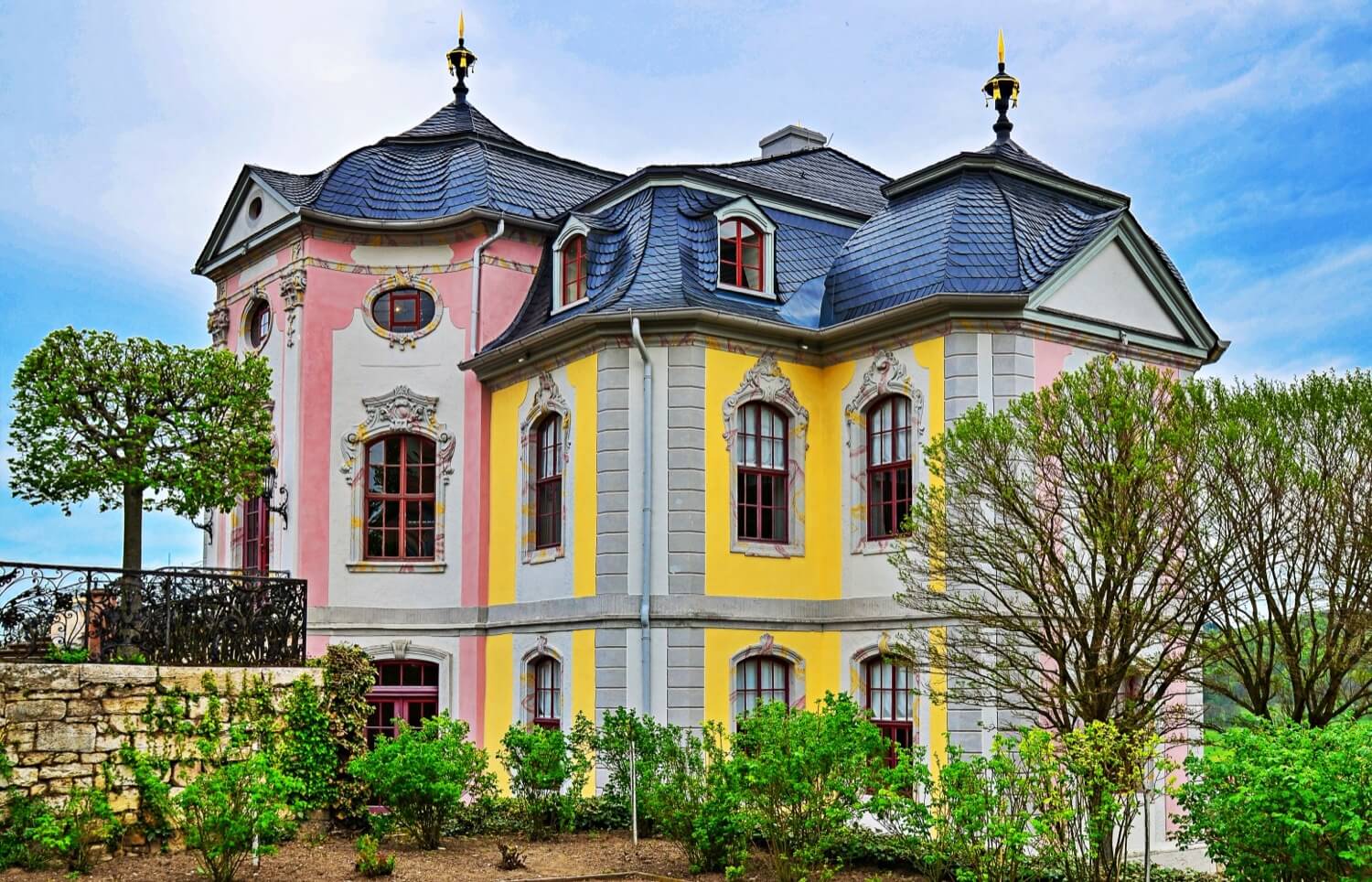
Dornburger Schlösser
Saale-Holzland-Kreis
11.8km
castle, chateau
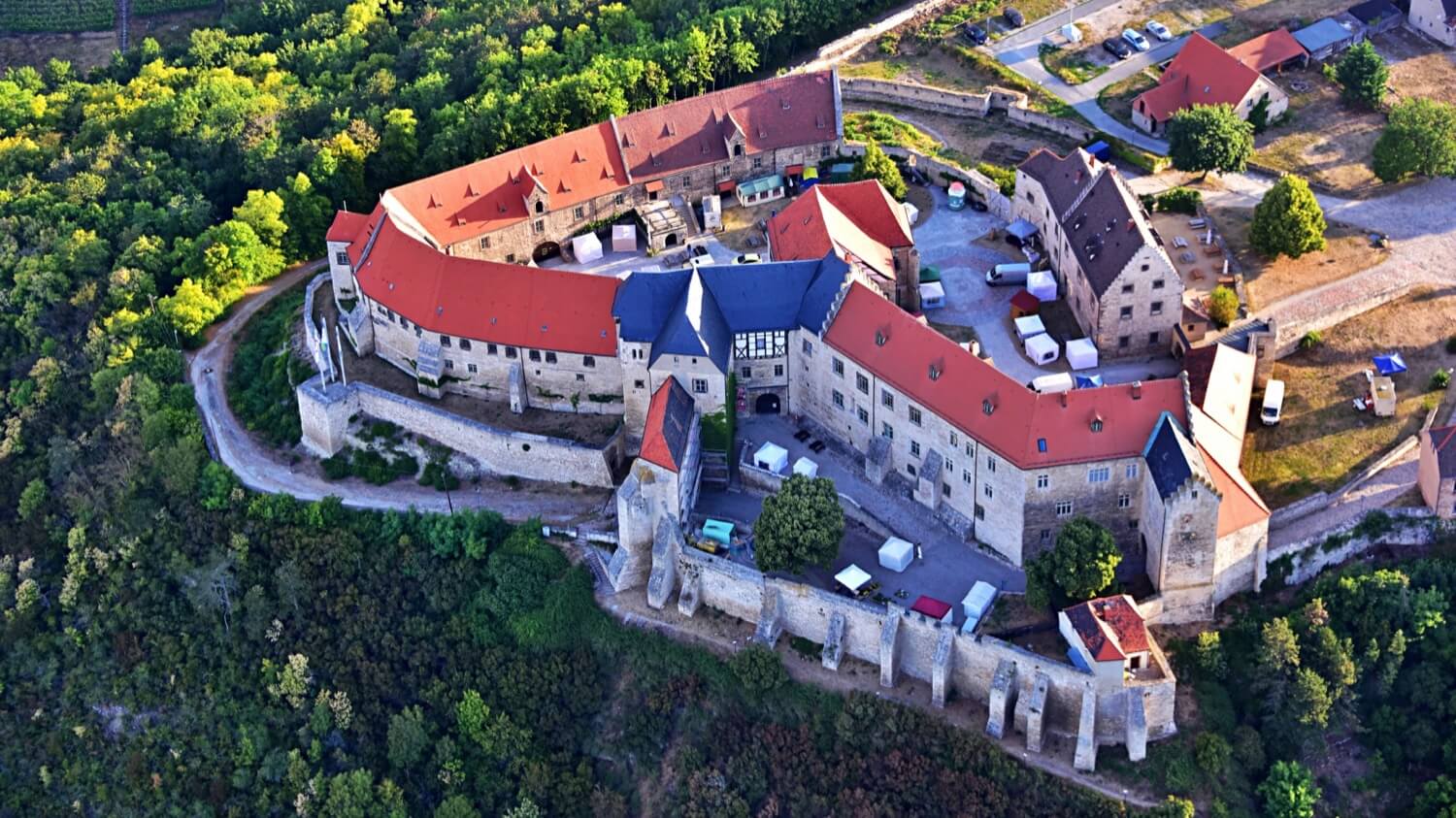
Schloss Neuenburg (Freyburg)
Burgenlandkreis
12.0km
castle, chateau
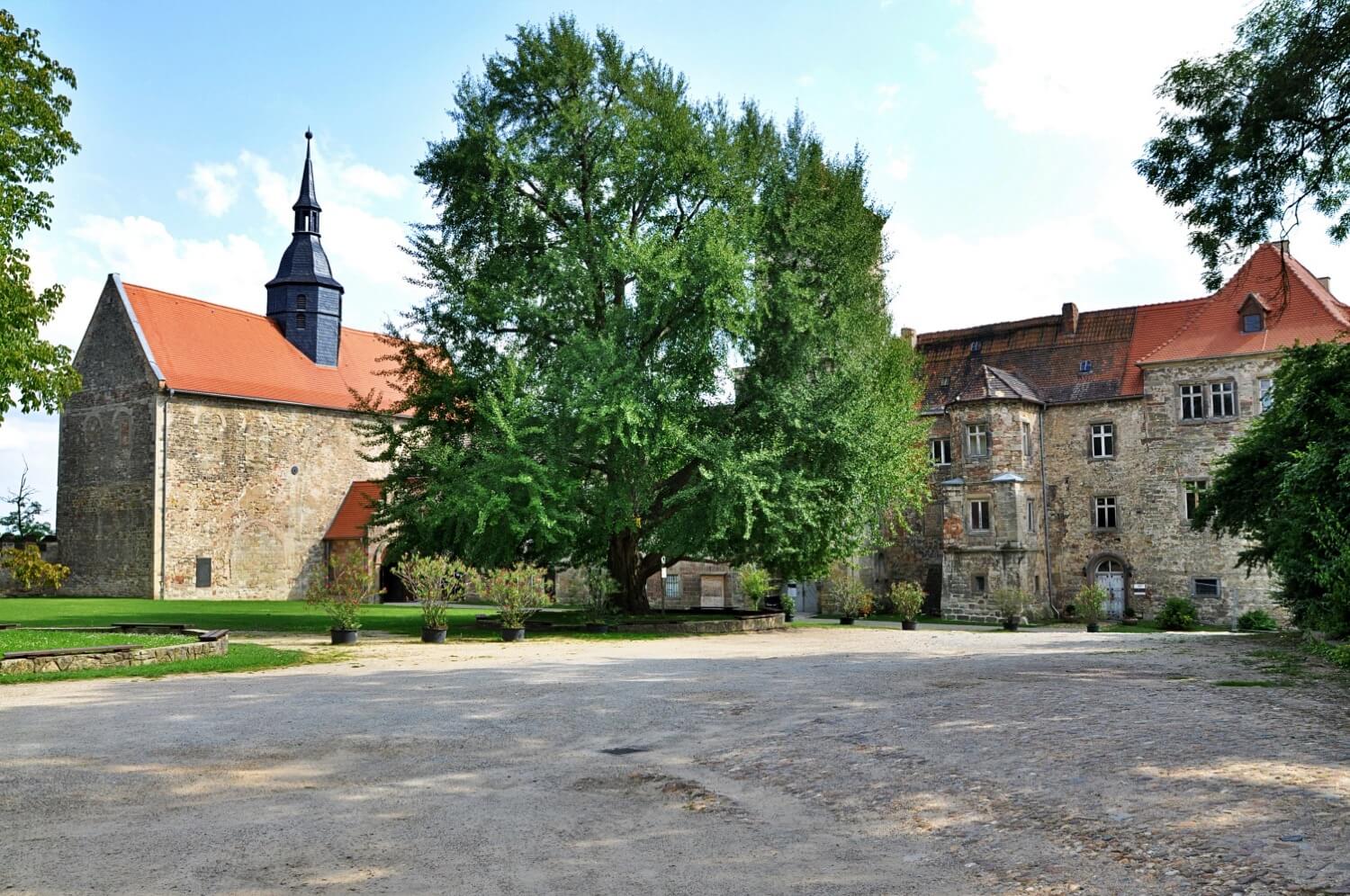
Schloss Goseck
Burgenlandkreis
15.0km
castle, chateau
